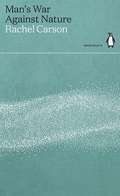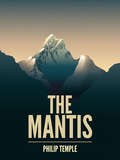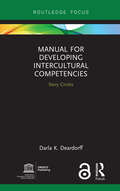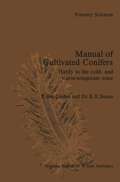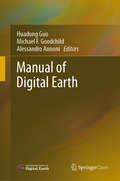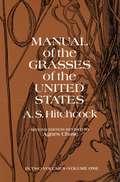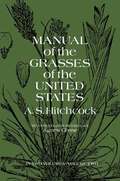- Table View
- List View
The Manhattan Secret: An absolutely heartbreaking and gripping historical novel
by Marie-Bernadette DupuyA dramatically powerful saga of secrets, love and betrayal for fans of Anna Jacobs, Nadine Dorries and Rita Bradshaw.***FROM THE 4-MILLION COPY BESTSELLING AUTHOR******RATED 5 STARS BY REAL READERS***"A wonderfully romantic saga full of action" -Hart, 5* Amazon reviewer"A fantastic book - I can't wait to read the next volume!" -Michele, 5* Amazon reviewerOctober 1886. Catherine and Guillaume Duquesne set off to New York with their six-year-old daughter Elisabeth. But the young couple's dreams of freedom and independence soon turn into a nightmare when Catherine dies during the journey and Guillaume is assaulted and left for dead soon after their arrival on American soil. A wealthy family adopts Elisabeth, who grows up spoiled and happy. But when she turns 16, she learns the truth about her origins and decides to return to France to meet her real family. Upon her arrival she realises that her grandfather's house, too, is seething with secrets...What readers think"The author is hugely talented." -Julie, 5* Amazon reviewer"Very attaching characters ... I'm impatient to read the next instalment!" -5* Babelio reviewer"I just had to get the rest of the series." -Jean-Pierre, 5* fnac.com reviewer"Reads very well - wait until you read the ending!" -Françoise, 5* Amazon reviewer"An extraordinary author. I strongly recommend!" -Nathalie, 5* Amazon reviewer"I didn't know the author - the book is excellent. -Mimi, 5* Amazon reviewer
Manifesto for Living in the Anthropocene
by Katherine Gibson Deborah Bird Rose Ruth FincherThe recent 10,000 year history of climatic stability on Earth that enabled the rise of agriculture and domestication, the growth of cities, numerous technological revolutions, and the emergence of modernity is now over. We accept that in the latest phase of this era, modernity is unmaking the stability that enabled its emergence. Over the 21st century severe and numerous weather disasters, scarcity of key resources, major changes in environments, enormous rates of extinction, and other forces that threaten life are set to increase. But we are deeply worried that current responses to these challenges are focused on market-driven solutions and thus have the potential to further endanger our collective commons. Today public debate is polarized. On one hand we are confronted with the immobilizing effects of knowing “the facts” about climate change. On the other we see a powerful will to ignorance and the effects of a pernicious collaboration between climate change skeptics and industry stakeholders. Clearly, to us, the current crisis calls for new ways of thinking and producing knowledge. Our collective inclination has been to go on in an experimental and exploratory mode, in which we refuse to foreclose on options or jump too quickly to “solutions.”
Mankind and Deserts 2: Water and Salts
by Fernand Joly Guilhem BourriéThe wild beauty of deserts has always been a source of fascination the world over. Mankind and Deserts 2 – the second of three volumes – focuses on water, its absence or indeed its extreme scarcity, as well as on the ways in which salts come to be formed in areas such as these. Aridity of the climate does not exclude rainfall, after which deserts flourish; wet mists, dew, exceptional events separated by years of total drought. Water flows into temporary and disorganized networks but, occasionally, large rivers cross the deserts, giving rise to vibrant civilizations: the Nile, Tigris and Euphrates, Niger, to name a few. Temporary or permanent lakes collect water in basins without outlet to the ocean, referred to as endorrheic basins, such as Lake Chad. This results in salt accumulation and evaporitic formations. A large variety of salts crystallize, in addition to halite, among which is potash. Halite – common salt – is an essential resource and its trade leads to the creation of salt caravans, used to exchange it with gold, even on a 1-1 weight basis, generating subsequent wealth. From ancient, almost mythical, exploration to modern scientific studies, deserts have come to be better known yet still hold great appeal. This book traces the history of their knowledge while providing a basis for understanding their features and the tools needed for their protection, in an ever-changing world.
Mankind and Deserts 2: Water and Salts
by Fernand Joly Guilhem BourrieThe wild beauty of deserts has always been a source of fascination the world over. Mankind and Deserts 2 – the second of three volumes – focuses on water, its absence or indeed its extreme scarcity, as well as on the ways in which salts come to be formed in areas such as these. Aridity of the climate does not exclude rainfall, after which deserts flourish; wet mists, dew, exceptional events separated by years of total drought. Water flows into temporary and disorganized networks but, occasionally, large rivers cross the deserts, giving rise to vibrant civilizations: the Nile, Tigris and Euphrates, Niger, to name a few. Temporary or permanent lakes collect water in basins without outlet to the ocean, referred to as endorrheic basins, such as Lake Chad. This results in salt accumulation and evaporitic formations. A large variety of salts crystallize, in addition to halite, among which is potash. Halite – common salt – is an essential resource and its trade leads to the creation of salt caravans, used to exchange it with gold, even on a 1-1 weight basis, generating subsequent wealth. From ancient, almost mythical, exploration to modern scientific studies, deserts have come to be better known yet still hold great appeal. This book traces the history of their knowledge while providing a basis for understanding their features and the tools needed for their protection, in an ever-changing world.
Mankind and Deserts 3: Wind in Deserts and Civilizations
by Guilhem Bourrie Fernand JolyThe wild beauty of deserts has always been a source of fascination the world over. Mankind and Deserts 3 – the third and final volume – focuses on wind, frequently present in all deserts, either hot or cold. Wind plays a major role in aridity and landscapes bear numerous forms due to its action, erosion, transportation and surface formations, some discreet and others spectacular, such as vast expanses of towering yardangs. Aeolian dynamics lead to dune formation, simple or associated with sand ridges or ergs, as in the Sahara. Mankind has attempted, to varying degrees of success, to cope with sand accumulation; ignoring aeolian dynamics has led many development projects to failure. This is developed by Yann Callot, a Professor at Lyon University who studied aeolian dynamics in the Sahara. Traditional societies have adapted to live in deserts, establishing vibrant civilizations with original ways of living, managing water resources and creating routes for trade, especially for salt. In a changing environment, useful lessons can be drawn from the genius of mankind's adaptation to such diverse and fragile environments. This is explained by Marc Côte, who was a Professor at Constantine (Algeria) and Aix-en-Provence Universities. From ancient, almost mythical, exploration to modern scientific studies, deserts have come to be better known yet still hold great appeal. This book traces the history of their knowledge while providing a basis for understanding their features and the tools needed for their protection, in an ever-changing world.
Mankind and Deserts 3: Wind in Deserts and Civilizations
by Fernand Joly Guilhem BourriéThe wild beauty of deserts has always been a source of fascination the world over. Mankind and Deserts 3 – the third and final volume – focuses on wind, frequently present in all deserts, either hot or cold. Wind plays a major role in aridity and landscapes bear numerous forms due to its action, erosion, transportation and surface formations, some discreet and others spectacular, such as vast expanses of towering yardangs. Aeolian dynamics lead to dune formation, simple or associated with sand ridges or ergs, as in the Sahara. Mankind has attempted, to varying degrees of success, to cope with sand accumulation; ignoring aeolian dynamics has led many development projects to failure. This is developed by Yann Callot, a Professor at Lyon University who studied aeolian dynamics in the Sahara. Traditional societies have adapted to live in deserts, establishing vibrant civilizations with original ways of living, managing water resources and creating routes for trade, especially for salt. In a changing environment, useful lessons can be drawn from the genius of mankind's adaptation to such diverse and fragile environments. This is explained by Marc Côte, who was a Professor at Constantine (Algeria) and Aix-en-Provence Universities. From ancient, almost mythical, exploration to modern scientific studies, deserts have come to be better known yet still hold great appeal. This book traces the history of their knowledge while providing a basis for understanding their features and the tools needed for their protection, in an ever-changing world.
Man's War Against Nature (Green Ideas)
by Rachel CarsonIn twenty short books, Penguin brings you the classics of the environmental movement.With the precision of a scientist and the simplicity of a fable, Rachel Carson reveals how man-made pesticides have destroyed wildlife, creating a world of polluted streams and silent songbirds.Over the past 75 years, a new canon has emerged. As life on Earth has become irrevocably altered by humans, visionary thinkers around the world have raised their voices to defend the planet, and affirm our place at the heart of its restoration. Their words have endured through the decades, becoming the classics of a movement. Together, these books show the richness of environmental thought, and point the way to a fairer, saner, greener world.
The Mantis: A mountaineering novel
by Philip TempleIt is not the courage to go back up that we need. It's the courage to go down. Just to go on … ' In 1977 a British expedition led by Himalayan veteran Geoff Strickland, summiteer of K2 and Everest among others, set off to attempt the first ascent of unclimbed Puthemojar - the 'Mantis' - in the Karakoram. 25,311 feet high, renowned for its difficulty, and with a fearsome reputation, the Mantis had claimed the life of at least one climber on each of the previous expeditions that had attempted to scale its complex series of ridges and icefalls. In order to claim the coveted first ascent, Strickland put together a small team comprising the cream of British mountaineering talent: his long-time Himalayan climbing partner and photographer Michael Blackmore; the redoubtable northerner Joe Dodge, as tough as they come; Dodge's regular partner and another veteran of numerous Himalayan expeditions Doug Lowrie; and two young guns - Brit Alan Wyllie, and Kiwi Peter Chase, a pair who had been tearing up the Alpine rule book with daring ascents on the steepest and most difficult faces. Although Michael Blackmore's 1980 record of the climb - The Last Challenge - has become a classic of mountaineering literature, Blackmore himself was never satisfied it told the full story of the events on Puthemojar in 1977. Before his death in 2000, Blackmore had prepared a draft manuscript - a 'creative narrative' - of the expedition which, with thanks to Blackmore's widow, has now been completed by award-winning author and mountaineer Philip Temple. While perhaps best regarded as a work of fiction, The Mantis tells for the first time the gripping story of that 1977 British expedition to Puthemojar. It is a portrait of these men, their drive, this mountain and a credible testimony of just what went on, high on the Mantis.
Manual for Developing Intercultural Competencies: Story Circles (Routledge Focus on Environment and Sustainability)
by Darla K. DeardorffThis book presents a structured yet flexible methodology for developing intercultural competence in a variety of contexts, both formal and informal. Piloted around the world by UNESCO, this methodology has proven to be effective in a range of different contexts and focused on a variety of different issues. It, therefore can be considered an important resource for anyone concerned with effectively managing the growing cultural diversity within our societies to ensure inclusive and sustainable development. Intercultural competence refers to the skills, attitudes, and behaviours needed to improve interactions across difference, whether within a society (differences due to age, gender, religion, socio-economic status, political affiliation, ethnicity, and so on) or across borders. The book serves as a tool to develop those competences, presenting an innovative adaptation of what could be considered an ancient tradition of storytelling found in many cultures. Through engaging in the methodology, participants develop key elements of intercultural competence, including greater self-awareness, openness, respect, reflexivity, empathy, increased awareness of others, and in the end, greater cultural humility. This book will be of great interest to intercultural trainers, policy makers, development practitioners, educators, community organizers, civil society leaders, university lecturers and students – all who are interested in developing intercultural competence as a means to understand and appreciate difference, develop relationships with those across difference, engage in intercultural dialogue, and bridge societal divides. The Open Access version of this book, available at https://www.taylorfrancis.com/books/9780429244612, has been made available under a Creative Commons Attribution-Non Commercial-No Derivatives 4.0 license.
Manual for Developing Intercultural Competencies: Story Circles (Routledge Focus on Environment and Sustainability)
by Darla K. DeardorffThis book presents a structured yet flexible methodology for developing intercultural competence in a variety of contexts, both formal and informal. Piloted around the world by UNESCO, this methodology has proven to be effective in a range of different contexts and focused on a variety of different issues. It, therefore can be considered an important resource for anyone concerned with effectively managing the growing cultural diversity within our societies to ensure inclusive and sustainable development. Intercultural competence refers to the skills, attitudes, and behaviours needed to improve interactions across difference, whether within a society (differences due to age, gender, religion, socio-economic status, political affiliation, ethnicity, and so on) or across borders. The book serves as a tool to develop those competences, presenting an innovative adaptation of what could be considered an ancient tradition of storytelling found in many cultures. Through engaging in the methodology, participants develop key elements of intercultural competence, including greater self-awareness, openness, respect, reflexivity, empathy, increased awareness of others, and in the end, greater cultural humility. This book will be of great interest to intercultural trainers, policy makers, development practitioners, educators, community organizers, civil society leaders, university lecturers and students – all who are interested in developing intercultural competence as a means to understand and appreciate difference, develop relationships with those across difference, engage in intercultural dialogue, and bridge societal divides. The Open Access version of this book, available at https://www.taylorfrancis.com/books/9780429244612, has been made available under a Creative Commons Attribution-Non Commercial-No Derivatives 4.0 license.
Manual for Soil Analysis - Monitoring and Assessing Soil Bioremediation (Soil Biology #5)
by Rosa Margesin Franz SchinnerThis volume presents detailed descriptions of methods for evaluating, monitoring and assessing bioremediation of soil contaminated with organic pollutants or heavy metals. Traditional soil investigation techniques, including chemical, physical and microbiological methods, are complemented by the most suitable modern methods, including bioreporter technology, immunological, ecotoxicological and molecular assays. Step-by-step procedures, lists of required equipment and reagents and notes on evaluation and quality control allow immediate application
Manual for Survival: A Chernobyl Guide to the Future
by Kate Brown'Remarkable . . . grips with the force of a thriller' Robert MacFarlaneAn astonishing exposé of the aftermath of Chernobyl - and the plot to cover up the truthThe official death toll of the 1986 Chernobyl accident, 'the worst nuclear disaster in history', is only 54, and stories today commonly suggest that nature is thriving there. Yet award-winning historian Kate Brown uncovers a much more disturbing story, one in which radioactive isotopes caused hundreds of thousands of casualties, and the magnitude of this human and ecological catastrophe has been actively suppressed.Based on a decade of archival and on-the-ground research, Manual for Survival is a gripping account of the consequences of nuclear radiation in the wake of Chernobyl - and the plot to cover it up. As Brown discovers, Soviet scientists, bureaucrats, and civilians documented staggering increases in cases of birth defects, child mortality, cancers and a multitude of life-altering diseases years after the disaster. Worried that this evidence would blow the lid on the effects of massive radiation release from weapons-testing during the Cold War, scientists and diplomats from international organizations, including the UN, tried to bury or discredit it. Yet Brown also encounters many everyday heroes, often women, who fought to bring attention to the ballooning health catastrophe, and adapt to life in a post-nuclear landscape, where dangerously radioactive radioactive berries, distorted trees and birth defects still persist today.An astonishing historical detective story, Manual for Survival makes clear the irreversible impact of nuclear energy on every living thing, not just from Chernobyl, but from eight decades of radiaoactive fallout from weapons development.
Manual of Cultivated Conifers: Hardy in the Cold- and Warm-Temperature Zone (Forestry Sciences #4)
by P. den Ouden B.K. BoomAs an introduction to the present book I would like to explain how it was, that I, a commercial nurseryman, became so keenly interested in Conifers and their nomen clature. In August 1924 the Dutch Dendrological Society was founded and at the same time a Committee for Nomenclature of woody plants was set up and I served on this committee as one of the members. Our first activity was to bring the catalogues of the various leading nurserymen in the Netherlands into line with the International Rules of Botanical Nomenclature and also to check their nursery stock. Formerly these catalogues had shown a rather confused nomenclature, nurserymen having usually made use of a variety of inconsistent books as guides in compiling their catalogues. In the course of the work a close co-operation between scientific and practical workers developed. Although I had also fully contributed to the correct naming of hardy shrubs and perennials, 1 was most interested in Conifers. I had tried out several species, had grown a wide choice of garden forms and selected types of particular merit for propagation. My special love for Conifers lead to the publication of my Name-list of Conifers (1937), which was adopted as a standard for varietal names at the International Horticultural Congress in Berlin (1938). Later I prepared my book 'Coniferen, Ephedra en Ginkgo' in the Dutch language (1949); compiling the Conifers cultivated or known to be grown in the Netherlands and Belgium at that time.
Manual of Digital Earth
by Michael F. Goodchild Huadong Guo Alessandro AnnoniThis open access book offers a summary of the development of Digital Earth over the past twenty years. By reviewing the initial vision of Digital Earth, the evolution of that vision, the relevant key technologies, and the role of Digital Earth in helping people respond to global challenges, this publication reveals how and why Digital Earth is becoming vital for acquiring, processing, analysing and mining the rapidly growing volume of global data sets about the Earth. The main aspects of Digital Earth covered here include: Digital Earth platforms, remote sensing and navigation satellites, processing and visualizing geospatial information, geospatial information infrastructures, big data and cloud computing, transformation and zooming, artificial intelligence, Internet of Things, and social media. Moreover, the book covers in detail the multi-layered/multi-faceted roles of Digital Earth in response to sustainable development goals, climate changes, and mitigating disasters, the applications of Digital Earth (such as digital city and digital heritage), the citizen science in support of Digital Earth, the economic value of Digital Earth, and so on. This book also reviews the regional and national development of Digital Earth around the world, and discusses the role and effect of education and ethics. Lastly, it concludes with a summary of the challenges and forecasts the future trends of Digital Earth. By sharing case studies and a broad range of general and scientific insights into the science and technology of Digital Earth, this book offers an essential introduction for an ever-growing international audience.
Manual of the Grasses of the United States, Volume One
by A. S. U.S. Dept. of Agriculture A. S. HitchcockThis work is actually the definitive encyclopedia of United States grass life. Compiled from the U.S. National Herbarium collection, the largest of its kind in the world, it is the only complete manual of U.S. grasses available and one of the basic reference works on U.S. plant life. It catalogs and describes in detail all 1,398 numbered species in 169 numbered genera found in this country, plus 120 species in 16 genera of the so-called “waifs.” Professor Hitchcock is the former Chief Botanist in charge of systematic agrostology for the U.S. Department of Agriculture, by whom the work was originally published, and an internationally known authority.The heart of the book is its detailed descriptions of the family of grasses, the two main subfamilies, the tribes, genera, and species. Quick finding keys are provided for the identification of tribes and genera. Each of the species is given thorough botanical description, including various aspects of its morphology — size, shape, form of culms, blades, panicles, spikes, and flowers — and height, proper planting season, and range of distribution are noted. The Manual also outlines the common uses to which grasses are put and discusses in general terms their distribution, classification, nomenclature, and common names. The 1,199 drawings make identification of any grass species found in the United States a virtual certainty. The appended synonymy of alternate names for each species provides an authoritative taxonomy, eliminating confusion.The nature lover with no more technical equipment than a keen eye can use this manual with profit, for a glossary of botanical terms is included. Naturalists, botanists, agriculturists, and horticulturists will find it valuable as a field and research guide to virtually all the grasses that grow in this country.
Manual of the Grasses of the United States, Volume Two
by A. S. U.S. Dept. of Agriculture A. S. HitchcockThis work is actually the definitive encyclopedia of United States grass life. Compiled from the U.S. National Herbarium collection, the largest of its kind in the world, it is the only complete manual of U.S. grasses available and one of the basic reference works on U.S. plant life. It catalogs and describes in detail all 1,398 numbered species in 169 numbered genera found in this country, plus 120 species in 16 genera of the so-called “waifs.” Professor Hitchcock is the former Chief Botanist in charge of systematic agrostology for the U.S. Department of Agriculture, by whom the work was originally published, and an internationally known authority.The heart of the book is its detailed descriptions of the family of grasses, the two main subfamilies, the tribes, genera, and species. Quick finding keys are provided for the identification of tribes and genera. Each of the species is given thorough botanical description, including various aspects of its morphology — size, shape, form of culms, blades, panicles, spikes, and flowers — and height, proper planting season, and range of distribution are noted. The Manual also outlines the common uses to which grasses are put and discusses in general terms their distribution, classification, nomenclature, and common names. The 1,199 drawings make identification of any grass species found in the United States a virtual certainty. The appended synonymy of alternate names for each species provides an authoritative taxonomy, eliminating confusion.The nature lover with no more technical equipment than a keen eye can use this manual with profit, for a glossary of botanical terms is included. Naturalists, botanists, agriculturists, and horticulturists will find it valuable as a field and research guide to virtually all the grasses that grow in this country.
A Manual of the Mammalia: An Homage to Lawlor’s “Handbook to the Orders and Families of Living Mammals”
by Douglas A. Kelt James L. PattonThe taxonomy of recent mammals has lately undergone tremendous revision, but it has been decades since the last update to Timothy E. Lawlor’s acclaimed identification guide the Handbook to the Orders and Families of Living Mammals. Integrating the latest advances in research, Douglas A. Kelt and James L. Patton provide this long-overdue update in their new, wholly original work, A Manual of the Mammalia. Complemented by global range maps, high-resolution photographs of skulls and mandibles by Bill Stone, and the outstanding artwork of Fiona Reid, this book provides an overview of biological attributes of each higher taxon while highlighting key and diagnostic characters needed to identify skulls and skins of all recent mammalian orders and most families. Kelt and Patton also place taxa in their currently understood supra-familial clades, and discuss current challenges in higher mammal taxonomy. Including a comprehensive review of mammalian anatomy to provide a foundation for understanding all characters employed throughout, A Manual of the Mammalia is both a user-friendly handbook for students learning to identify higher mammal taxa and a uniquely comprehensive, up-to-date reference for mammalogists and mammal-lovers from across the globe.
A Manual of the Mammalia: An Homage to Lawlor’s “Handbook to the Orders and Families of Living Mammals”
by Douglas A. Kelt James L. PattonThe taxonomy of recent mammals has lately undergone tremendous revision, but it has been decades since the last update to Timothy E. Lawlor’s acclaimed identification guide the Handbook to the Orders and Families of Living Mammals. Integrating the latest advances in research, Douglas A. Kelt and James L. Patton provide this long-overdue update in their new, wholly original work, A Manual of the Mammalia. Complemented by global range maps, high-resolution photographs of skulls and mandibles by Bill Stone, and the outstanding artwork of Fiona Reid, this book provides an overview of biological attributes of each higher taxon while highlighting key and diagnostic characters needed to identify skulls and skins of all recent mammalian orders and most families. Kelt and Patton also place taxa in their currently understood supra-familial clades, and discuss current challenges in higher mammal taxonomy. Including a comprehensive review of mammalian anatomy to provide a foundation for understanding all characters employed throughout, A Manual of the Mammalia is both a user-friendly handbook for students learning to identify higher mammal taxa and a uniquely comprehensive, up-to-date reference for mammalogists and mammal-lovers from across the globe.
A Manual of the Mammalia: An Homage to Lawlor’s “Handbook to the Orders and Families of Living Mammals”
by Douglas A. Kelt James L. PattonThe taxonomy of recent mammals has lately undergone tremendous revision, but it has been decades since the last update to Timothy E. Lawlor’s acclaimed identification guide the Handbook to the Orders and Families of Living Mammals. Integrating the latest advances in research, Douglas A. Kelt and James L. Patton provide this long-overdue update in their new, wholly original work, A Manual of the Mammalia. Complemented by global range maps, high-resolution photographs of skulls and mandibles by Bill Stone, and the outstanding artwork of Fiona Reid, this book provides an overview of biological attributes of each higher taxon while highlighting key and diagnostic characters needed to identify skulls and skins of all recent mammalian orders and most families. Kelt and Patton also place taxa in their currently understood supra-familial clades, and discuss current challenges in higher mammal taxonomy. Including a comprehensive review of mammalian anatomy to provide a foundation for understanding all characters employed throughout, A Manual of the Mammalia is both a user-friendly handbook for students learning to identify higher mammal taxa and a uniquely comprehensive, up-to-date reference for mammalogists and mammal-lovers from across the globe.
A Manual of the Mammalia: An Homage to Lawlor’s “Handbook to the Orders and Families of Living Mammals”
by Douglas A. Kelt James L. PattonThe taxonomy of recent mammals has lately undergone tremendous revision, but it has been decades since the last update to Timothy E. Lawlor’s acclaimed identification guide the Handbook to the Orders and Families of Living Mammals. Integrating the latest advances in research, Douglas A. Kelt and James L. Patton provide this long-overdue update in their new, wholly original work, A Manual of the Mammalia. Complemented by global range maps, high-resolution photographs of skulls and mandibles by Bill Stone, and the outstanding artwork of Fiona Reid, this book provides an overview of biological attributes of each higher taxon while highlighting key and diagnostic characters needed to identify skulls and skins of all recent mammalian orders and most families. Kelt and Patton also place taxa in their currently understood supra-familial clades, and discuss current challenges in higher mammal taxonomy. Including a comprehensive review of mammalian anatomy to provide a foundation for understanding all characters employed throughout, A Manual of the Mammalia is both a user-friendly handbook for students learning to identify higher mammal taxa and a uniquely comprehensive, up-to-date reference for mammalogists and mammal-lovers from across the globe.
Manufactured Gas Plant Remediation: A Case Study
by Allen W. Hatheway Thomas B. SpeightThe assessment, remediation, and redevelopment of manufactured gas plant (MGP) sites pose a significant technical and financial challenge to successor property owners, including municipalities and other public entities undertaking brownfields revitalization, and to their consulting environmental engineers. Due to the toxicity of many coal tar constituents, sites contaminated as a result of gasworks operations pose a significant threat to public health. This book will discuss the history of the manufactured gas industry in Massachusetts (the largest in the US), as well as the toxicity of gasworks waste products, technical challenges in the cleanup process, and the process for site cleanups.
Manufactured Gas Plant Remediation: A Case Study
by Allen W. Hatheway Thomas B. SpeightThe assessment, remediation, and redevelopment of manufactured gas plant (MGP) sites pose a significant technical and financial challenge to successor property owners, including municipalities and other public entities undertaking brownfields revitalization, and to their consulting environmental engineers. Due to the toxicity of many coal tar constituents, sites contaminated as a result of gasworks operations pose a significant threat to public health. This book will discuss the history of the manufactured gas industry in Massachusetts (the largest in the US), as well as the toxicity of gasworks waste products, technical challenges in the cleanup process, and the process for site cleanups.
Manufacturing of Natural Fibre Reinforced Polymer Composites
by Mohd Sapuan Salit Mohammad Jawaid Nukman Bin Yusoff M. Enamul HoqueNatural fibre composite is an emerging material that has great potential to be used in engineering application. Oil palm, sugar palm, bagasse, coir, banana stem, hemp, jute, sisal, kenaf, roselle, rice husk, betul nut husk and cocoa pod are among the natural fibres reported to be used as reinforcing materials in polymer composites. Natural fibre composites were used in many industries such as automotive, building, furniture, marine and aerospace industries. The advantages of natural fibre composites include low cost, renewable, abundance, light weight, less abrasive and they are suitable to be used in semi or non-structural engineering components. Research on various aspects of natural fibre composites such as characterization, determination of properties and design have been extensively carried out. However, publications that reported on research of manufacture of natural fibre composites are very limited. Specifically, although manufacturing methods of components from natural fibre composites are similar to those of components from conventional fibre composites such as glass, carbon and Kevlar fibres, modification of equipment used for conventional fibre composites may be required. This book fills the gap of knowledge in the field of natural fibre composites for the research community. Among the methods reported that are being used to produce components from natural fibre composites include hand lay-up, compression moulding, filament winding, injection moulding, resin transfer moulding, pultrusion and vacuum bag moulding. This book is also intended to address some research on secondary processing such as machining and laser welding of natural fibre composites. It is hoped that publication of this book will provide the readers new knowledge and understanding on the manufacture of natural fibre composites.
Many Layers of Ecocentrism: Revering Life, Revering the Earth
by Abhik GuptaThis book unveils the myriad streams of ecocentric thoughts that have been flowing through the human mind – in indigenous communities, in the wisdom of philosophers, in the creative expressions of poets and writers – sometimes latent, but sometimes more explicit. The strength of this book lies in the fact that it attempts to show that ecocentrism had not emerged suddenly as a distinct line of philosophical thought or found its place among the various normative approaches toward nature, but the seeds of ecocentrism had always been running through human societies. Thus, this book not only emphasizes the “unity of life” but also reveals the inherent unity of all hues of ecocentrism. The book adopts a multidisciplinary approach, which is essential to dwell on a topic like ecocentrism which permeates the domains of disciplines as disparate as science, philosophy, religion, normative ethics, myths and folklore, poetry, and literature, among others. Despite this eclectic approach, the book attempts to maintain continuity among the chapters and present these concepts in a simple form that will be easily accessible by readers from all conceivable backgrounds. This book would be useful to the students, researchers, and faculty from the fields of ecology and environmental science, philosophy, sociology, religious studies, and literature. It will also be an indispensable companion for all nature lovers, activists, and general readers interested in the emergence and evolution of environmental thoughts.
Many Layers of Ecocentrism: Revering Life, Revering the Earth
by Abhik GuptaThis book unveils the myriad streams of ecocentric thoughts that have been flowing through the human mind – in indigenous communities, in the wisdom of philosophers, in the creative expressions of poets and writers – sometimes latent, but sometimes more explicit. The strength of this book lies in the fact that it attempts to show that ecocentrism had not emerged suddenly as a distinct line of philosophical thought or found its place among the various normative approaches toward nature, but the seeds of ecocentrism had always been running through human societies. Thus, this book not only emphasizes the “unity of life” but also reveals the inherent unity of all hues of ecocentrism. The book adopts a multidisciplinary approach, which is essential to dwell on a topic like ecocentrism which permeates the domains of disciplines as disparate as science, philosophy, religion, normative ethics, myths and folklore, poetry, and literature, among others. Despite this eclectic approach, the book attempts to maintain continuity among the chapters and present these concepts in a simple form that will be easily accessible by readers from all conceivable backgrounds. This book would be useful to the students, researchers, and faculty from the fields of ecology and environmental science, philosophy, sociology, religious studies, and literature. It will also be an indispensable companion for all nature lovers, activists, and general readers interested in the emergence and evolution of environmental thoughts.




